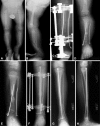Periosteal grafting for congenital pseudarthrosis of the tibia: a preliminary report
- PMID: 18953621
- PMCID: PMC2628232
- DOI: 10.1007/s11999-008-0556-1
Periosteal grafting for congenital pseudarthrosis of the tibia: a preliminary report
Abstract
The results of treatment of congenital pseudarthrosis of the tibia (CPT) are frequently unsatisfactory because of the need for multiple operations for recalcitrant nonunion, residual deformities, and limb-length discrepancies (LLD). Although the etiology of CPT is basically unknown, recent reports suggest the periosteum is the primary site for the pathologic processes in CPT. We hypothesized complete excision of the diseased periosteum and the application of a combined approach including free periosteal grafting, bone grafting, and intramedullary (IM) nailing of both the tibia and fibula combined with Ilizarov fixation would improve union rates and reduce refracture rates. We retrospectively reviewed 20 patients at two centers. The minimum followup was 2 years (mean, 4.3 years; range, 2-10.7 years). Union was achieved after the primary operation in all patients. Ten refractures occurred in eight of the 20 patients (two each in two patients, one each in six patients). Seven patients underwent seven secondary surgical procedures to simultaneously treat refracture and angular deformities. We used bisphosphonate as adjuvant therapy in three patients with refracture without subsequent refracture. We performed no amputations in these 20 patients. All patients were braced through skeletal maturity. Combining periosteal and bone grafting, IM nailing, and Ilizarov fixation is an effective treatment. IM nailing decreases the severity of subsequent fracture.
Level of evidence: Level IV, therapeutic study. See the Guidelines for Authors for a complete description of levels of evidence.
Figures





References
-
- {'text': '', 'ref_index': 1, 'ids': [{'type': 'PubMed', 'value': '819445', 'is_inner': True, 'url': 'https://pubmed.ncbi.nlm.nih.gov/819445/'}]}
- Andersen KS. Congenital pseudarthrosis of the leg. Late results. J Bone Joint Surg Am. 1976;58:657–662. - PubMed
-
- {'text': '', 'ref_index': 1, 'ids': [{'type': 'DOI', 'value': '10.1007/BF00387333', 'is_inner': False, 'url': 'https://doi.org/10.1007/bf00387333'}, {'type': 'PubMed', 'value': '6150696', 'is_inner': True, 'url': 'https://pubmed.ncbi.nlm.nih.gov/6150696/'}]}
- Blauth M, Harms D, Schmidt D, Blauth W. Light- and electron-microscopic studies in congenital pseudarthrosis. Arch Orthop Trauma Surg. 1984;103:269–277. - PubMed
-
- {'text': '', 'ref_index': 1, 'ids': [{'type': 'DOI', 'value': '10.1097/00004694-199709000-00019', 'is_inner': False, 'url': 'https://doi.org/10.1097/00004694-199709000-00019'}, {'type': 'PubMed', 'value': '9592010', 'is_inner': True, 'url': 'https://pubmed.ncbi.nlm.nih.gov/9592010/'}]}
- Boero S, Catagni M, Donzelli O, Facchini R, Frediani PV. Congenital pseudarthrosis of the tibia associated with neurofibromatosis-1: treatment with Ilizarov’s device. J Pediatr Orthop. 1997;17:675–684. - PubMed
-
- {'text': '', 'ref_index': 1, 'ids': [{'type': 'PubMed', 'value': '7083685', 'is_inner': True, 'url': 'https://pubmed.ncbi.nlm.nih.gov/7083685/'}]}
- Boyd HB. Pathology and natural history of congenital pseudarthrosis of the tibia. Clin Orthop Relat Res. 1982;166:5–13. - PubMed
-
- {'text': '', 'ref_index': 1, 'ids': [{'type': 'PubMed', 'value': '13610959', 'is_inner': True, 'url': 'https://pubmed.ncbi.nlm.nih.gov/13610959/'}]}
- Boyd HB, Sage FP. Congenital pseudarthrosis of the tibia. J Bone Joint Surg Am. 1958;40:1245–1270. - PubMed
MeSH terms
LinkOut - more resources
Full Text Sources
Medical
Research Materials

